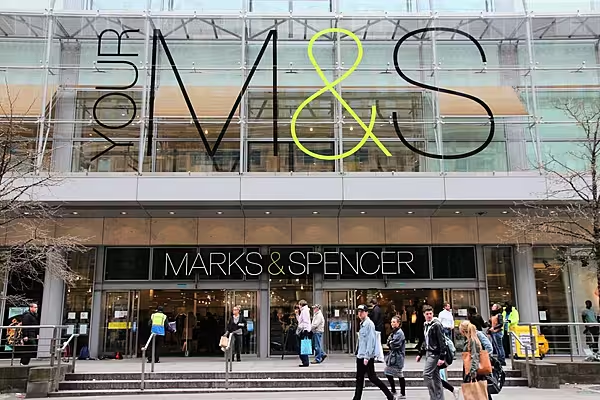Sales at Marks & Spencer fell in the first half of its financial year, with demand for clothing and food hit by disruption from the latest attempt to reinvent Britain's most famous retailer.
After more than a decade of failed turnaround programmes, M&S is now targeting sustainable, profitable growth in three to five years by shutting less successful stores. It warned on Wednesday that sales were unlikely to improve soon.
"Trading conditions remain challenging and the headwinds from the growth of online competition and the march of the discounters remain strong in all our markets," it said.
Shares in M&S, which have fallen 4% so far this year, were down 2.2% at 0900 GMT.
M&S launched its latest turnaround plan last November, two months after retail veteran Archie Norman joined as chairman to work alongside Chief Executive Steve Rowe, a company lifer.
Like other established retailers, M&S is trying to deal with the shift of clothing sales online along with unrelenting price competition from supermarkets and discounters.
Pressure on consumer spending, a shift in expenditure towards experiences and away from clothing, as well as unhelpful weather trends have also hampered efforts to revive its business.
Results on Wednesday showed that its previously reliable food business was particularly weak, with like-for-like sales down 2.9 percent -- below expectations of a 2% fall and reflecting the need for price cuts.
Gross margin in the division fell 25 basis points.
Sales in its clothing and home division -- long the nation's first port of call for school uniforms, interview suits and underwear -- fell 1.1 percent on a like-for-like basis while its gross margin was down 20 basis points.
"Against the background of profound structural change in our industry, we are leaving no stone unturned and reshaping our business, its organisation and culture," said Chief Executive Rowe.
Looking Jaded
The group said its full-year outlook was broadly unchanged and it maintained its interim dividend however as cost cuts helped underlying profit to rise by 2 percent to £223.5 millio ($293 million) in the six months to 29 September, ahead of analysts' average forecast of £203 million.
Laith Khalaf, senior analyst at Hargreaves Lansdown, said the broad direction of travel at M&S would not come as a shock to anyone, although he noted that the food business looked particularly jaded.
M&S has previously attracted more affluent shoppers who pick up meal deals and wine on their way home. Khalaf said that approach was now facing competition from online competitors such as Hello Fresh, Deliveroo and Just Eat.
"These providers present a particular threat to M&S seeing as many of its customers are buying a quick meal for that night, rather than a full weekly shop," he said. The latest M&S five-year programme of store closures and relocations aims to cut excess selling space in its clothing business; increased technology investment and includes moves to make the misfiring food business more competitive.
M&S is targeting 100 British store closures by 2022, as it strives to make at least a third of clothing and home sales online. It has said it could close even more as it manages its property estate more pro-actively.
News by Reuters, edited by Checkout, edited by Donna Ahern. Click subscribe to sign up for the Checkout print edition.





